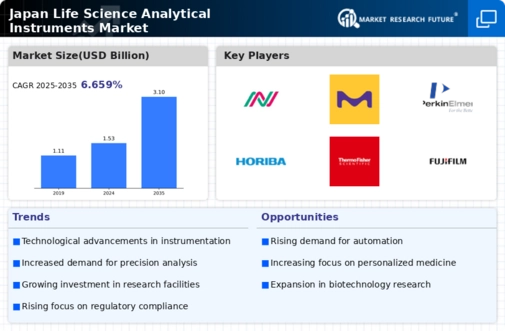Emergence of Biopharmaceuticals
The biopharmaceutical sector in Japan is rapidly evolving, leading to a heightened demand for specialized analytical instruments. As biopharmaceutical companies focus on developing innovative therapies, the need for precise analytical techniques becomes paramount. The life science-analytical-instruments market is likely to benefit from this trend, as companies require advanced instruments for the characterization and quality assessment of biopharmaceutical products. The market is projected to grow by around 7% over the next few years, driven by the increasing complexity of biopharmaceuticals and the necessity for robust analytical solutions. This growth reflects the broader shift towards biopharmaceuticals, which is reshaping the landscape of the life science-analytical-instruments market.
Growing Focus on Quality Control
Quality control remains a critical aspect of the life science-analytical-instruments market in Japan, particularly in the pharmaceutical and food industries. The increasing regulatory requirements for product safety and efficacy are compelling companies to invest in high-quality analytical instruments. This focus on quality assurance is likely to drive the adoption of advanced analytical technologies that ensure compliance with stringent regulations. As organizations strive to maintain high standards, the demand for reliable and accurate analytical instruments is expected to rise. Consequently, the life science-analytical-instruments market may experience a growth trajectory of approximately 4.5% as companies prioritize quality control measures in their operations.
Increased Funding for Life Sciences
In Japan, the life science sector is witnessing a surge in funding from both public and private sources, which is significantly impacting the life science-analytical-instruments market. Government initiatives aimed at promoting innovation and research in life sciences have led to increased financial support for research projects. For instance, the Japanese government has allocated substantial budgets to enhance healthcare research and development, which in turn drives the demand for analytical instruments. This influx of funding is expected to facilitate the acquisition of cutting-edge analytical technologies, thereby fostering growth in the market. As a result, the life science-analytical-instruments market is likely to benefit from this financial momentum, with an anticipated growth rate of around 5% annually.
Rising Demand for Advanced Research
The life science-analytical-instruments market in Japan is experiencing a notable increase in demand for advanced research capabilities. This trend is driven by the growing need for precise and reliable analytical data in various fields, including pharmaceuticals, biotechnology, and environmental science. As research institutions and laboratories seek to enhance their analytical capabilities, investments in sophisticated instruments are likely to rise. The market is projected to grow at a CAGR of approximately 6.5% over the next five years, reflecting the increasing emphasis on research and development. Furthermore, the integration of automation and data analytics in laboratory processes is expected to further propel the demand for advanced analytical instruments, thereby shaping the future landscape of the life science-analytical-instruments market.
Technological Integration in Laboratories
The integration of technology in laboratory settings is transforming the life science-analytical-instruments market in Japan. Laboratories are increasingly adopting digital solutions, such as cloud computing and artificial intelligence, to enhance their analytical capabilities. This technological integration not only improves efficiency but also enables real-time data analysis and remote monitoring of experiments. As laboratories seek to optimize their operations, the demand for technologically advanced analytical instruments is expected to rise. The life science-analytical-instruments market may witness a growth rate of approximately 6% as organizations embrace these innovations to stay competitive in a rapidly evolving landscape.



















Leave a Comment